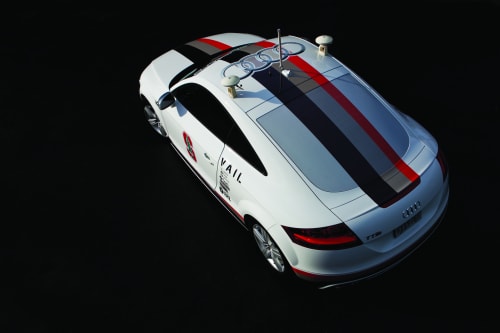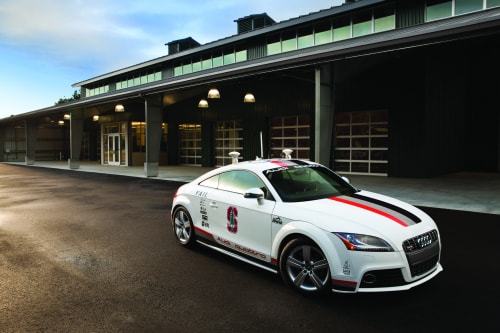Last week, the news of the world's first autonomous vehicle managing to conquer the famous Pikes Peak circled the Internet. Impressive, apocalyptic, unexciting, whatever were the words which described the feat, the fact remains: the TTS managed to complete one of the most challenging courses known to man, without his direct input.
The car went uphill and reached the top 27 minutes after it started, much slower than the cars driven by humans. For the record though, no human was able, regardless of the car he/she was driving, to complete the course in under 10 minutes.
But how does the very special TTS works? Are there magical forces at work here? Is it a trick?
THE CAR
The Autonomous Audi TTS is based on a street-ready Audi TTS sports car. The carmaker said it chose this model not because it looks stunning, but because it allows for a better integration of the systems which make it autonomous.
Aside for some high-tech gadgets, the car is just a regular TTS, if we can say that. It is powered by a 265 hp engine, it comes equipped with the famous quattro all-wheel drive system and a semiautomatic DSG gearbox. The fact that the car already uses a drive-by-wire throttle made it ideal for the task at hand.
The autonomous part in the TTS has been developed by Audi with the strong support of Stanford University, the Volkswagen Group Electronics Research Lab (ERL) and Oracle. Stanford and the ERL brought with them the experience gained during the DARPA Challenges of past years, while Oracle provided the much needed software.
The software used in the car has been integrated with the GPS already featured into the vehicle. As a comparison, the creators of the car said that as far as the hardware was concerned, the car is no more complicated than what can be found in a standard laptop. The software part however is much more elaborate.
The TTS is equipped with two computers, located in its trunk. One of them is being used to run safety critical algorithms, using the Oracle Java RTS. The other is being utilized as a tool to run vehicle dynamics algorithms.
The calculus made by the computers are being fed into the GPS system, making it capable of keeping the vehicle within two centimeters of the center line of a normal course (for the run on Pikes Peak, due to the extreme conditions, a one meter margin was used). Thanks to the algorithms used, the vehicle was capable of maintaining its stability during the Pikes Peak run despite the various surfaces, speeds and conditions.
The Java system was used to to acquire GPS position coordinates and distribute them to all of the other components in the system. Java was also acting as a backup safety system, being ready to bring the car to a stop had the traditional systems failed.
According to Oracle, the systems used in the TTS have been devised in such a manner that the computers were able to differentiate processes based on their importance and precisely determine when time-critical functions should be executed.
"We are not trying to replace the driver," professor Chris Gerdes from the Stanford University said at one point, "Instead we want to learn how the best drivers control the car so we can develop systems that assist our robotic driver and, eventually, you and me."
Aside for some high-tech gadgets, the car is just a regular TTS, if we can say that. It is powered by a 265 hp engine, it comes equipped with the famous quattro all-wheel drive system and a semiautomatic DSG gearbox. The fact that the car already uses a drive-by-wire throttle made it ideal for the task at hand.
The autonomous part in the TTS has been developed by Audi with the strong support of Stanford University, the Volkswagen Group Electronics Research Lab (ERL) and Oracle. Stanford and the ERL brought with them the experience gained during the DARPA Challenges of past years, while Oracle provided the much needed software.
THE SYSTEMS
When the parties involved in the project decided to go forward with it, it became clear that they needed to build on both previous experience and devise new systems. Oracle was perhaps the most important partner of the project, being in charge with developing algorithms and implementing the existing the Java real-Time System (Java RTS - addresses the issues of latency and unpredictable response times) and Solaris.The software used in the car has been integrated with the GPS already featured into the vehicle. As a comparison, the creators of the car said that as far as the hardware was concerned, the car is no more complicated than what can be found in a standard laptop. The software part however is much more elaborate.
The TTS is equipped with two computers, located in its trunk. One of them is being used to run safety critical algorithms, using the Oracle Java RTS. The other is being utilized as a tool to run vehicle dynamics algorithms.
The calculus made by the computers are being fed into the GPS system, making it capable of keeping the vehicle within two centimeters of the center line of a normal course (for the run on Pikes Peak, due to the extreme conditions, a one meter margin was used). Thanks to the algorithms used, the vehicle was capable of maintaining its stability during the Pikes Peak run despite the various surfaces, speeds and conditions.
The Java system was used to to acquire GPS position coordinates and distribute them to all of the other components in the system. Java was also acting as a backup safety system, being ready to bring the car to a stop had the traditional systems failed.
According to Oracle, the systems used in the TTS have been devised in such a manner that the computers were able to differentiate processes based on their importance and precisely determine when time-critical functions should be executed.
GOAL
The developers of the autonomous TTS where not driven, this time, by the need to create a piece of technology for DARPA. Instead, what has been learned during the development of the vehicle will be applied to enhance a driver's abilities. Meaning, if you like, a natural evolution of the primitive systems we currently refer to as driver assistance systems."We are not trying to replace the driver," professor Chris Gerdes from the Stanford University said at one point, "Instead we want to learn how the best drivers control the car so we can develop systems that assist our robotic driver and, eventually, you and me."






